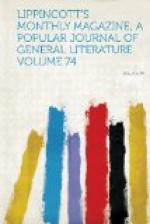We had abandoned our chapaya—which, we may add for the benefit of future travelers, we had greatly improved as against jolting by causing it to be suspended upon a pair of old springs which we found, a relic of some antique break-down, in a village on the route—and after a short journey on elephants were traveling dak; that is, by post. The dak-gharri is a comfortable-enough long carriage on four wheels, and constitutes the principal mode of conveyance for travelers in India besides the railway. It contains a mattress inside, for it goes night and day, and one’s baggage is strapped on top, much as in an American stage-coach after the “boot” is full. Frequent relays of horses along the route enable the driver to urge his animals from one station to the other with great speed, and the only other stoppages are at the dak-bungalows.
“I have discovered,” I said to Bhima Gandharva after a short experience of the dak-gharri and the dak-bungalows—“I have discovered a general remark about India which is not absurd: all the horses are devils and all the dak-bungalow servants are patriarchs.”
“If you judge by the heels of the former and the beards of the latter, it is true,” he said.
This little passage was based on the experience of the last relay, which was, however, little more than a repetition of many previous ones. My friend and I having arranged ourselves comfortably in the dak-gharri as soon as it was announced ready to start, the long and marvelously lean Indian who was our driver signified to his team by the usual horse-language that we should be glad to go. The horse did not even agitate his left ear—a phenomenon which I associate with a horse in that moment when he is quietly making up his mind to be fractious. “Go, my brother,” said the driver in a mellifluous and really fraternal tone of voice. The horse disdained to acknowledge the tie: he stood still.
[Illustration: A NAUTCHNI (OR BAYADERE) OF BARODA.]
Then the driver changed the relationship, with an access of tenderness in voice and in adjuration. “Go, my son,” he entreated. But the son stood as immovable as if he were going to remain a monument of filial impiety to all time.
“Go, my grandson, my love.” This seemed entirely too much for the animal, and produced apparently a sense of abasement in him which was in the highest degree uncomplimentary to his human kinsman and lover. He lay down. In so doing he broke several portions of the ragged harness, and then proceeded, with the most deliberate absurdity, to get himself thoroughly tangled in the remainder.
“I think I should be willing,” I said to my companion, “to carry that horse to Jhansi on my own shoulders if I could have the pleasure of seeing him blown from one of the rajah’s cannon in the, fort.”
But the driver, without the least appearance of discomposure, had dismounted, and with his long deft Hindu fingers soon released the animal, patched up his gear, replaced him between the shafts and resumed his place.




